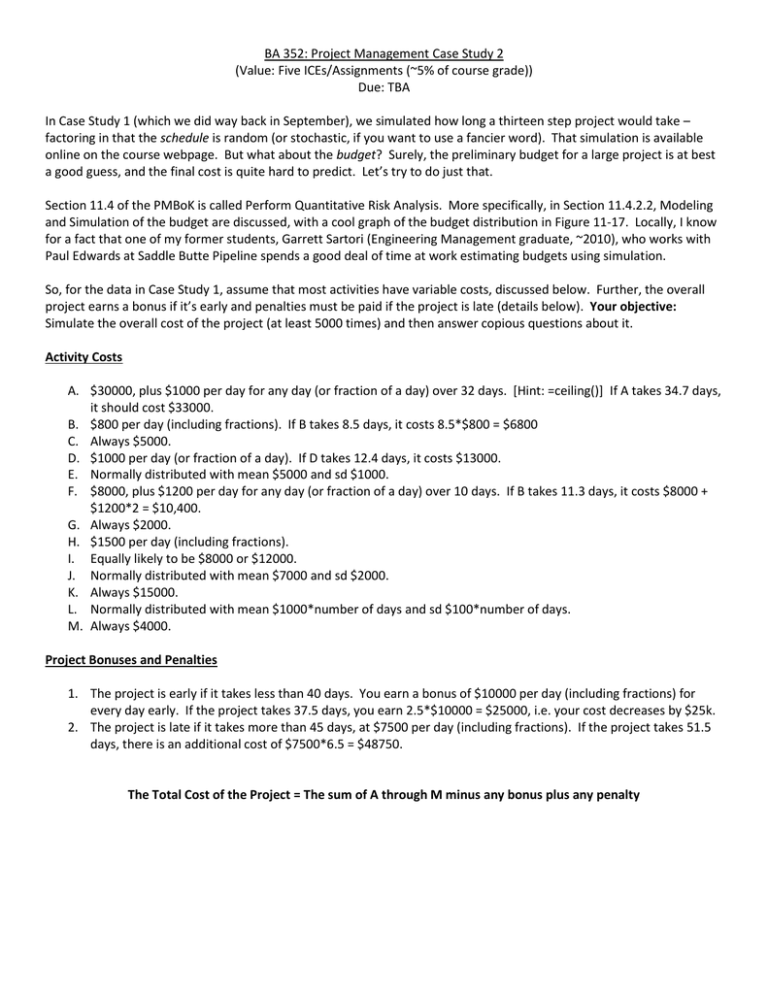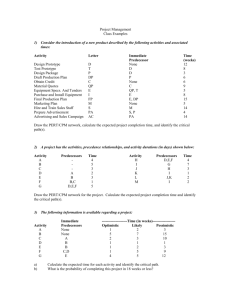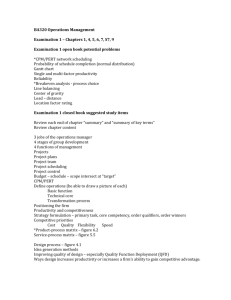BA 352: Project Management Case Study 2 (Value: Five ICEs
advertisement

BA 352: Project Management Case Study 2 (Value: Five ICEs/Assignments (~5% of course grade)) Due: TBA In Case Study 1 (which we did way back in September), we simulated how long a thirteen step project would take – factoring in that the schedule is random (or stochastic, if you want to use a fancier word). That simulation is available online on the course webpage. But what about the budget? Surely, the preliminary budget for a large project is at best a good guess, and the final cost is quite hard to predict. Let’s try to do just that. Section 11.4 of the PMBoK is called Perform Quantitative Risk Analysis. More specifically, in Section 11.4.2.2, Modeling and Simulation of the budget are discussed, with a cool graph of the budget distribution in Figure 11-17. Locally, I know for a fact that one of my former students, Garrett Sartori (Engineering Management graduate, ~2010), who works with Paul Edwards at Saddle Butte Pipeline spends a good deal of time at work estimating budgets using simulation. So, for the data in Case Study 1, assume that most activities have variable costs, discussed below. Further, the overall project earns a bonus if it’s early and penalties must be paid if the project is late (details below). Your objective: Simulate the overall cost of the project (at least 5000 times) and then answer copious questions about it. Activity Costs A. $30000, plus $1000 per day for any day (or fraction of a day) over 32 days. [Hint: =ceiling()] If A takes 34.7 days, it should cost $33000. B. $800 per day (including fractions). If B takes 8.5 days, it costs 8.5*$800 = $6800 C. Always $5000. D. $1000 per day (or fraction of a day). If D takes 12.4 days, it costs $13000. E. Normally distributed with mean $5000 and sd $1000. F. $8000, plus $1200 per day for any day (or fraction of a day) over 10 days. If B takes 11.3 days, it costs $8000 + $1200*2 = $10,400. G. Always $2000. H. $1500 per day (including fractions). I. Equally likely to be $8000 or $12000. J. Normally distributed with mean $7000 and sd $2000. K. Always $15000. L. Normally distributed with mean $1000*number of days and sd $100*number of days. M. Always $4000. Project Bonuses and Penalties 1. The project is early if it takes less than 40 days. You earn a bonus of $10000 per day (including fractions) for every day early. If the project takes 37.5 days, you earn 2.5*$10000 = $25000, i.e. your cost decreases by $25k. 2. The project is late if it takes more than 45 days, at $7500 per day (including fractions). If the project takes 51.5 days, there is an additional cost of $7500*6.5 = $48750. The Total Cost of the Project = The sum of A through M minus any bonus plus any penalty Calculations a. Assume that every activity finishes exactly on the most likely time. What is the budget? For the normally distributed times, assume they are exactly at the mean. Average the equally likely activity cost. b. Assume that every activity finishes on the optimistic time. What is the budget? For the normally distributed times, assume a z-score of -3. Use the lower equally likely activity cost. c. Assume that every activity finishes on the pessimistic time. What is the budget? For the normally distributed times, assume a z-score of +3. Use the higher equally likely activity cost. Calculations based on the Simulation d. e. f. g. h. i. What is the average cost of the project? How about the median? On average, how much over budget is the project compared to part a.? What is part e. as a percentage? How often (as a percentage) is the total cost less than or equal what you got in part a.? Assume that you hope to make a profit of $40000 on this project, based on your estimate from part a. How often (as a percentage) is the total cost of the project $40000 more than part a.? In other words, how often do you not only not make a profit but actually lose money on this project? What total cost is the top 1%? Graphs based on PivotTable j. Insert a PivotTable of the 5000+ simulated total costs. Group the data into groups of size 5000 or 10000 (I can’t decide which is better). Draw a bar graph of what the total cost distribution looks like. Is it symmetric or skewed to one side or the other? k. Now draw a cumulative line graph of the PivotTable data. First calculate the cumulative frequency of each group then draw it as a line. It should like something like Figure 11-17 from the PMBoK. Case 1 Act A B C D E F G H I J K L M I.P. ------B B C F F D E,G I,J,H H K a m 25 8 5 9 4 5 1.5 8 4 5 7 10 2 b 30 10 7 12 5 6 2 12 5 6 10 12 3 µ σ α β 50 16 18 15 8 17 5 24 9 8 14 16 6 1) Draw the PERT/CPM network. 2) Solve the network using CPM and the most likely times (m). a. What are the critical path, completion time and slack times? b. Draw a Gantt chart of the project. We didn’t do this in class, so look it up online. Then either draw it by hand or find a free program to do so online or figure out how to draw it in MS Excel. 3) Using the optimistic times (a), what is the fastest conceivable time that this project will take? Using the pessimistic times (b), what is the longest conceivable times that it will take? 4) Solve the network using CPM and the average times (µ). a. What is the critical path? Is it the same as before? b. How much longer is this critical path compared to 2)? 5) Using the PERT Normal distribution estimate technique, estimate: a. The probability the project is done “on time:” in 38 days or less. b. The probability the project is takes 50 days or more. c. When the project will be done with 95% and 99% certainty? 6) Now assume that the entire project completion time follows a Beta distribution with m = your answer from 2)a. and a and b your answers from 3). Repeat parts a. – c. of 5). 7) Using PERT simulation, re-estimate parts a. – c. of 5). Also, graph the distribution of completion times according to the simulation and show the relative frequency distribution of the times. 8) Executive Summary: (One page, typed.) Assume that you have an idiot boss (picture me?) that insists that this project should take exactly 40 days, no ifs ands or buts about it. Carefully explain why the only thing that’s certain about a real project is uncertainty. Paint a clear picture for your boss about what the actual completion time will look like and make him/her understand the project well enough that he could explain it to the client who is paying for it. Put together the results from 1) – 7) to make your case.






